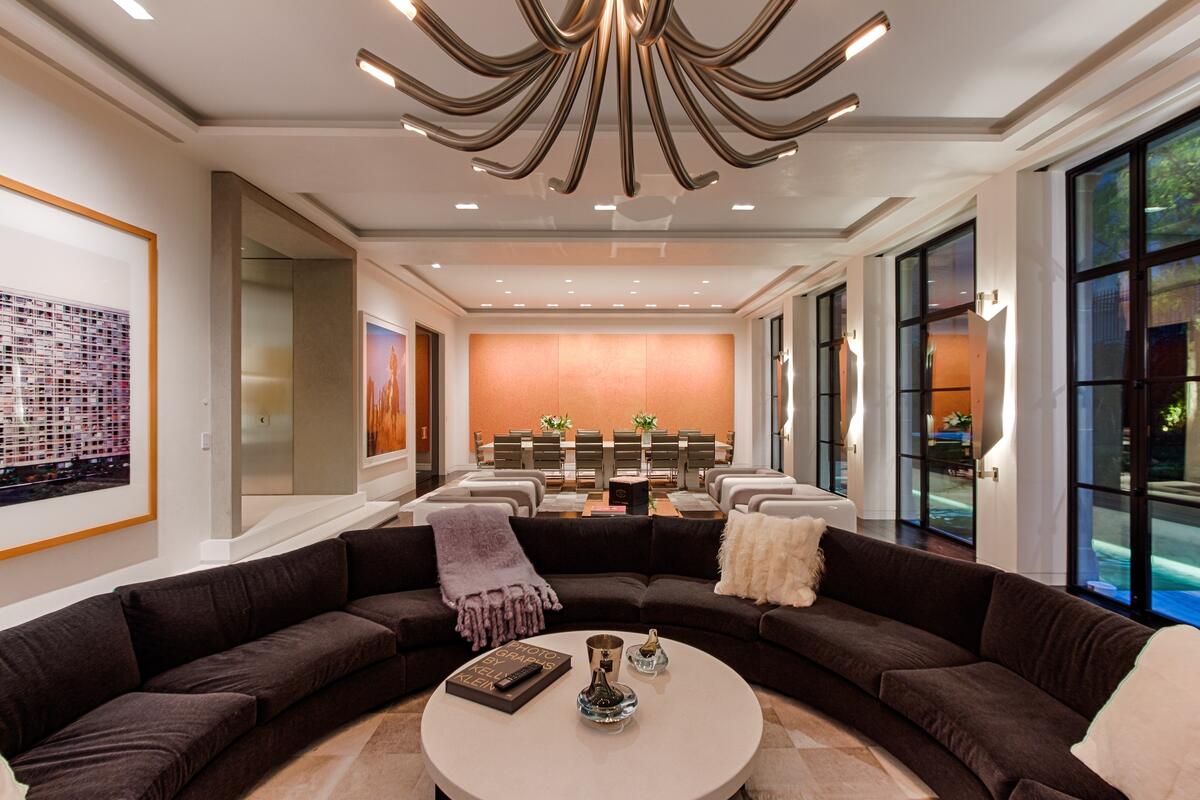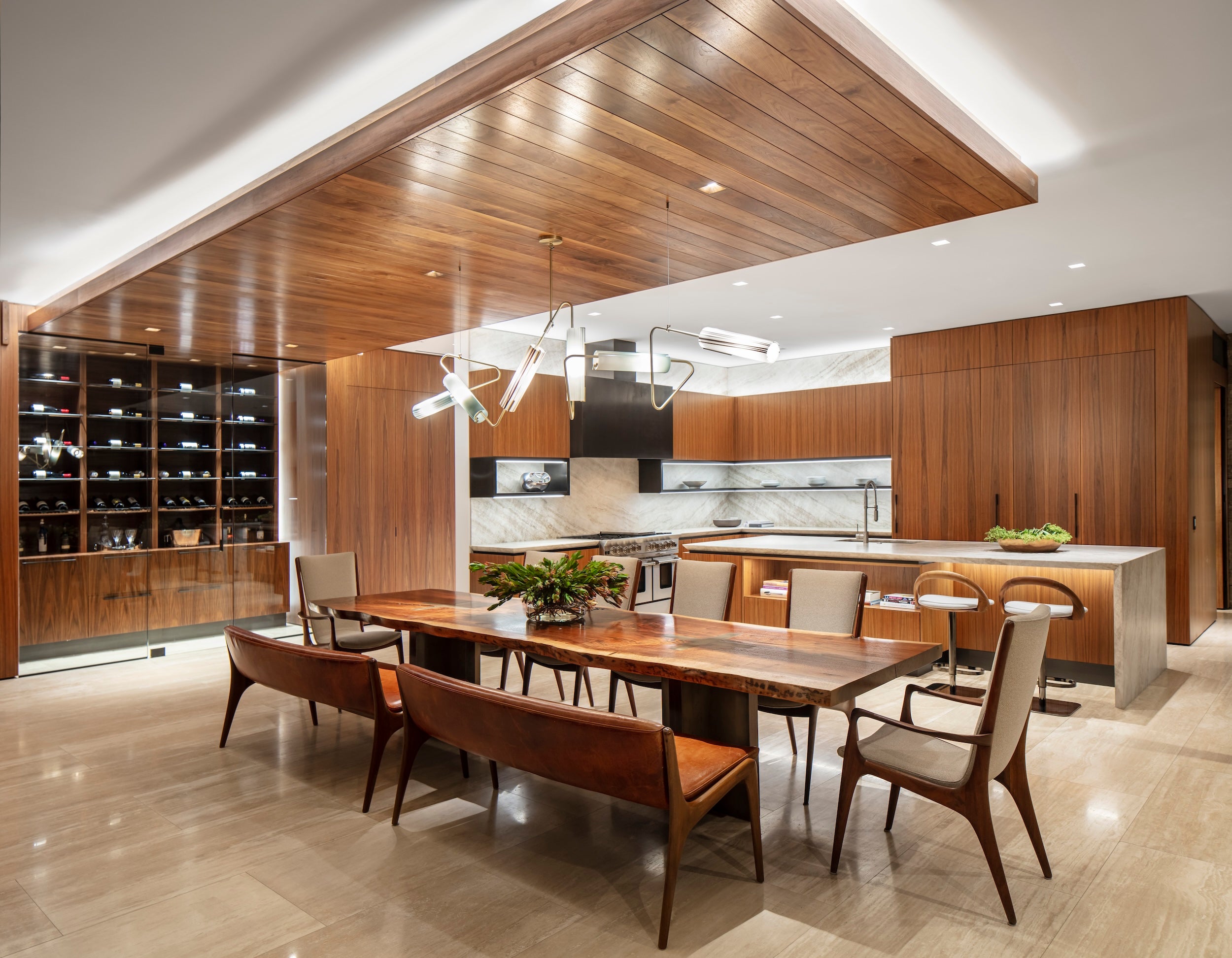In the field of interior design, lighting is in danger of falling into a blind spot. In shelter magazines, spaces are often either artificially lit for photo shoots or shown entirely with natural lighting, making it difficult to source lighting inspiration or imagery. Plus, it’s challenging to accurately represent lighting schemes in renderings, mood boards and CAD drawings. Sometimes it’s not clear how a space’s lighting is going to look until install day—and at that point, it’s too late. When the sun goes down, everything might go awry: Warm-toned bedroom walls turn sickly green, bathrooms become interrogation rooms, cozy libraries are eye-straining caves.
“One of the scarier things is that lighting is often the last thing installed, so it gets turned on days—if not hours—before the owner moves in sometimes,” says Brett Andersen, partner and principal designer at New York–based firm Focus Lighting. “You don’t know, as an interior designer, until that light gets turned on if it’s going to look the way you expect it to—and you don’t want to be surprised at that late stage.”
The best way to recapture some control over lighting mishaps is to hire an expert. Lighting designers (sometimes called architectural lighting designers or lighting specialists to differentiate them from those who design products and fixtures) can step in to create a lighting plan that’s embedded within the home’s structure. They work to create ambiance, crafting a mood that fits each room and complements the designer’s decor choices, while also serving the client’s functional needs—whether that’s a well-lit study or a bedroom that helps you wake up and fall asleep according to your schedule. Most designers who begin enlisting lighting specialists never go back. The end result, they say, is a space transformed from within, almost as if by magic.
BOH spoke with some of these interior designer converts and their go-to lighting specialists to better understand how they work, the benefits of an expertly lit space, and how the process could transform your next project.
Setting the Stage
In the lighting design world, it’s an inside joke that most people have career roots in theater. Having served on tech crew in high school, worked on college productions or even taken on a few off-Broadway lighting gigs before pivoting to architectural projects, there’s a shared understanding that the process of illuminating a stage’s many sets and characters is not so different from creating a home’s lighting scheme.
“Lighting is about drawing out things that you may not have necessarily seen, or drawing your eye in a way that you might in the theater—through the use of color angle, distribution and intensity,” says lighting designer Matthew Tirschwell of New York–based Tirschwell & Co. “It’s also about hiding the lights: Usually you’re not staring at the lights; you’re staring at the effect. And if it’s about the effect, then we can work behind the scenes to make that happen, which means concealing lights and [implementing] lighting as architecture. All of that comes from the theatrical.”
Like all good theater makers, lighting specialists need a document that tells them how the action will unfold—a script to better understand how each space is used, and by whom. “What we do very early on, just like the interior designer and the architect, is get into the client’s brain,” says Tirschwell. “We want to understand what their day-to-day routines are when they come home.”
Those early conversations look a lot like preliminary design consults, with discussions covering wake-up and sleep times, work-from-home needs and meal routines—all of which inform the color, intensity and availability of lighting in different areas. “What I call public spaces in the home—your living room, dining room … the places where you gather as a family and where you host friends and family when they come over—are often where our clients want that higher level of visual richness,” says Andersen.
Much like with interior design, the magic in lighting designs is often in the layers. Andersen uses the bedroom as an example: Start out with a single lighting source—say, a flush mount fixture on the center of the ceiling. Then start adding on: accent lights that shine on the curtains near the window, a little bookshelf light on the far side of the bedroom, a reading light near the bed that won’t disturb your partner. Install dimming capabilities as a final touch, and the space can be further tweaked and transformed at any hour of the day.
In each room, the investigation continues, as lighting designers home in on elements that are important to the clients and interior designers—illuminating a beloved piece of art, for example, or creating a cozy environment around the sofa. Armed with an understanding of the client’s needs and the designer’s overall vision for the space, these specialists can translate those moods and functional needs into an architectural layout, fixtures and proper technical specifications.

Bringing Light to Life
One major hurdle for lighting designers? Communicating a lighting scheme to end users. While many designers and homeowners are well-versed in decorative fixtures, specialists typically need to step into an educator role to explain the architectural elements of their work. For New York lighting consultant Staci Ruiz, it all starts with a concept meeting.
“I go into the space, and according to the existing conditions—or lack thereof—give [clients] all the applicable concepts, including the architecture, the electrical, the style and the budget,” she says.
They talk about the breadth of lighting options—including recessed lights, track lighting, linear LEDs, art lighting, and decorative features like portable lamps—and Ruiz draws up a list of potential fixtures to show clients in situ. At the following mock-up meeting, she brings sample fixtures into the space, plugged in and held at different angles. “We’re talking about color temperature, color rendering index, beam spread, dimming capabilities,” she says. “By the end of that meeting, we have a plan.”
Each lighting designer has their own unique approach to demonstrating their concept to clients before execution—and without letting anything get lost in translation. Tirschwell’s firm, for example, often leans on a range of presentation styles, from James Turrell–style mini-builds to scale models, to help communicate how a lighting scheme will manifest in a space.
“Show them a lighting plan, and clients don’t know how to read it,” says Tirschwell. “But building mock-ups and crafting with materials [at] that intersection of light and structure: That’s the happy playground for us. Rather than looking at a plan on-screen, they can see the real light, the real intensity, the balance, the reflectivity, the color temperature—and they can start co-designing.”
In a recent example, his firm built a foam core model, scaled about one inch to the foot, for the lighting plan on a client’s pool house. They brought it to the site, mounted it in the basement, blacked out the surrounding windows, turned out the lights, and brought their microlighting scheme to life. The best thing about the process? When the client said no, Tirschwell’s team was able to come up with a new and improved iteration before applying the lighting scheme to the actual project.
Dream team
Since much of the cabling and wiring involved in lighting is installed behind floors and ceilings, it’s better to complete the process before decor and furnishings enter the scene. But that presents a problem: Will an interior designer’s specified patterns, materials, colors and finishes appear as intended within the established lighting scheme?
“I think a lot of interior designers have experienced this: You agonize for days picking materials and finishes, and you make these beautiful trays that you present to your client, but often you’re presenting them in a conference room under office lighting,” says Andersen. “One of our big contributions to our collaborative partners is saying, ‘Grab those trays, get in the cab, come to our office up in Harlem, and come into our Light Lab.’”
The Light Lab—a two-story-tall, 25-by-25-foot room that he compares to a black box theater—serves as an experimental staging ground for potential lighting plans. The space is equipped not only with row after row of light fixture samples, but also with spare finishes and materials to allow visiting interior designers and clients to troubleshoot on the fly as their lighting scheme comes together.
“It can be kind of an iterative process: They come and see it, and they say, ‘Well, this doesn’t look quite as good as we thought. Let’s try this. What if we change the angle and bring up the texture of the material a little bit more?’” says Andersen. “You see their faces light up, because until then it’s just been a rendering. Until they see it with their own eyes, they’re not quite sure.”
Among the reasons to invest in a lighting designer, possibly the greatest is the gaping gulf between a basic lighting scheme and the variations that a professional can provide. As Tirschwell explains, most homes with builder-grade lighting are simply built to code—which is to say, the bare minimum.
“In bedrooms, for example, code means that technically you do not need to provide any lighting whatsoever—only a switched outlet,” he explains. “So what does every developer do? You walk in, there’s an entry, there’s a light switch for the bedroom, and directly below it, there’s an outlet—which is the most useless place to put a light—and there you go: You just spent $8 million on this apartment, and that’s your bedroom lighting.”
In addition to thinking beyond a one-size-fits-all approach, interior designer Jason Kalman of Los Angeles–based Magni Kalman Design says part of the benefit of hiring a lighting designer (he works with Tirschwell & Co. and hires a specialist for 95 percent of projects) is handing off the heavy task of understanding the rapidly changing world of lighting to someone who has the knowledge and bandwidth to master the material.
“The amount of work that I put into understanding all the latest and greatest furniture and finishes—going to Salone del Mobile or some other trade fair—[lighting specialists are] doing the same thing for lighting,” says Kalman. “There’s a wealth of information that they have, that would be difficult for me to have given the focus of what we’re working on as designers.”
As New York-based interior designer Drew McGukin (who often works with Staci Ruiz) explains, enlisting a lighting designer is also a crucial part of acting as a firm’s creative director, whose job is not only to set the vision, but also to build a well-rounded team to bring that dream to life. His own cabal includes a variety of specialists: kitchen designers, closet designers, pool and sauna designers. When it comes to lighting design, why not leave it to the experts?
“The more I grow in this business and the deeper I dive into what it means to be an interior designer, the less it’s about me,” says McGukin. “I’m really big on the team environment, and everyone needs to show up in the project and feel like they had a successful hand in something that’s beautiful about it.”





























